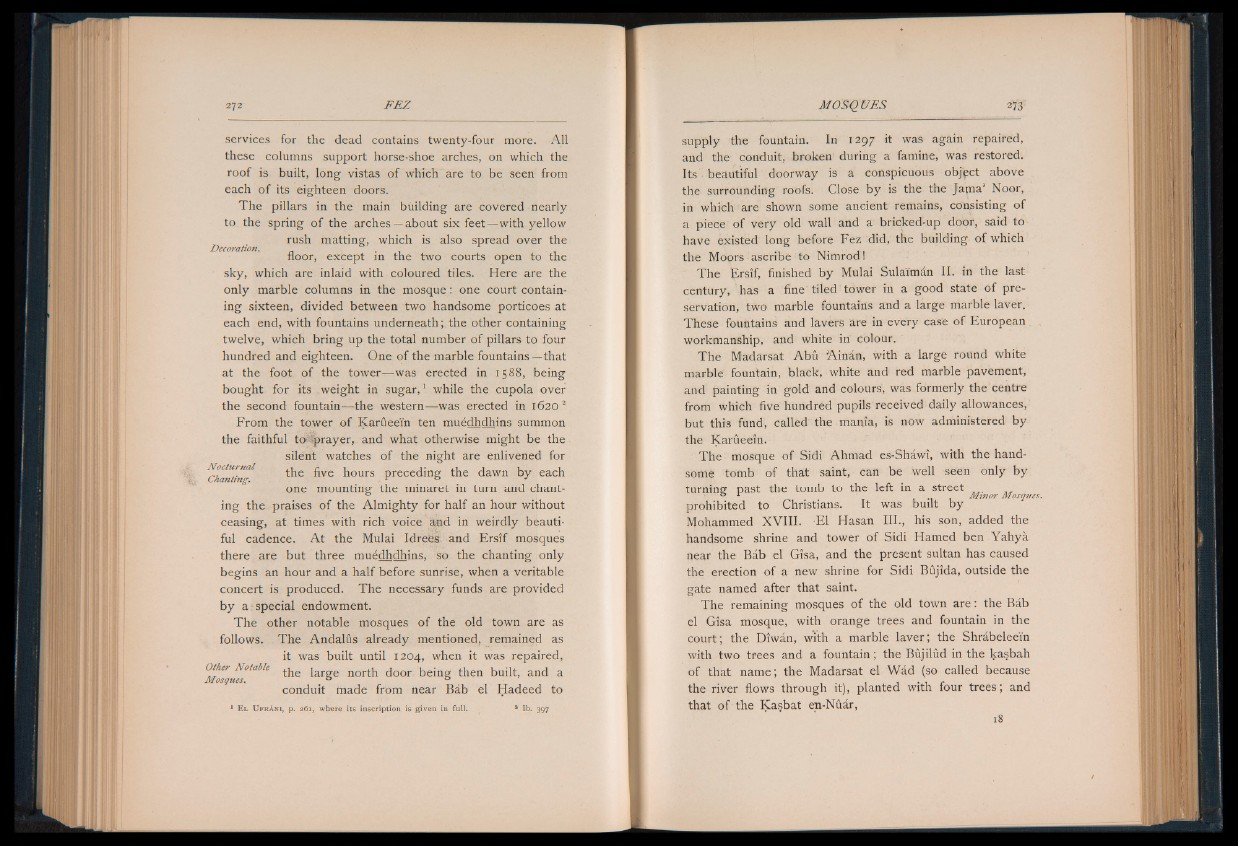
services for the dead contains twenty-four more. All
these columns support horse-shoe arches, on which the
roof is built, long vistas of which are to be seen from
each o f its eighteen doors.
The pillars in the main building are covered nearly
to the spring of the arches — about six feet— with yellow
rush matting, which is also spread over the
Decoration. .
floor, except in the two courts open to the
sky, which are inlaid with coloured tiles. Here are the
only marble columns in the mosque: one court containing
sixteen, divided between two handsome porticoes at
each end, with fountains underneath; the other containing
twelve, which bring up the total number of pillars to four
hundred and eighteen. One of the marble fountains r-that
at the foot of the tower— was erected in 1588, being
bought for its weight in sugar,1 while the cupola over
the second fountain— the western— was erected in 16203
From the tower of Karueein ten muedhdhins summon
the faithful to§Sprayer, and what otherwise might be the
silent watches of the night are enlivened for
Nocturnal f|ve hours preceding the dawn by each
one mounting the minaret in turn and chanting
the praises of the Almighty for half an hour without
ceasing, at times with rich voice and in weirdly beautiful
cadence. A t the Mulai Idrees and Ersif mosques
there are but three muedhdhins, so the chanting only
begins an hour and a half before sunrise, when a veritable
concert is produced. The necessary funds are provided
by a special endowment.
The other notable mosques of the old town are as
follows. The Andalus already mentioned, remained as
it was built until 1204, when it was repaired,
°Mosque°table large north door being then built, and a
conduit made from near Bab el Hadeed to
1 E l U f r a n i , p. 261, w h e r e i t s in s c r ip t io n is g iv e n in fu l l. 2 lb . 397
supply the fountain. In 1297 it was again repaired,
and the conduit, broken during a famine, was restored.
Its beautiful doorway is a conspicuous objpct above
the surrounding roofs. Close by is the the Japia‘ Noor,
in which are shown some ancient remains, consisting of
a piece of very old wall and a bricked-up door, said to
have existed long before Fez did, the building of which
the Moors ascribe to Nimrod!
The Ersif, finished by Mulai Sulaiman II. in the last
century, has a fine tiled tower in a good state of preservation,
two marble fountains and a large marble laver.
These fountains and lavers are in every case of European
workmanship, and white in colour.
The Madarsat Abu Ainan, with a large round white
marble fountain, black, white and red marble pavement,
and painting in gold and colours, was formerly the centre
from which five hundred pupils received daily allowances,
but this fund, called the mania, is now administered by
the Karueein.
The mosque of Sidi Ahmad es-Shawi, with the handsome
tomb of that saint, can be well seen only by
turning past the tomb to the left in a street • o r - Minor Mosques.
prohibited to Christians. It was built by
Mohammed XVIII. El Hasan III., his son, added the
handsome shrine and tower of Sidi Hamed ben Yahya
near the Bab el Gisa, and the present sultan has caused
the erection of a new shrine for Sidi Bujida, outside the
gate named after that saint.
The remaining mosques of the old town a re : the Bab
el Gisa mosque, with orange trees and fountain in the
court; the Diwan, with a marble laver; the Shrabeleein
with two trees and a fountain; the Bujilud in the kasbah
of that name; the Madarsat el Wad (so called because
the river flows through it), planted with four trees; and
that of the Kasbat en-Nuar,